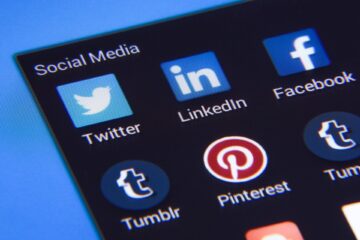![]()
Introduction:
Like all other branches of Intellectual Property, copyright law deals with the works of the human mind, more specifically so with the literary and artworks created. Within the scope of copyrights, all literary and artistic works such as writing, fine arts, music, computer programs, and electronic databases.[1]The Berne Convention[2] elaborates on the kinds of work protected by copyright to include every production in the fields of artistic, scientific, or literary domain in any form of expression that is unique and original.
Copyright law protects unique literary and artworks and since the motive behind copyrights is to encourage creative and innovative thinking, it gives exclusive right to publish or broadcast the work, reproduce, translate, or adopt.[3] Further, it also gives the owner the right to be duly credited when it is mentioned or fairly used. The law protects these rights and any infringement of the same incurs liability.
Internet, or the world wide web which began as a medium to access a vast database of knowledge, information, and commerce, is more often than not described as a menace by copyright owners. The free access and little to know download time have made infringement of copyrights very easy and thereby making copyright-protected work at a danger.[4]The main USP of the internet, to be able to transfer and store information at a really low cost is what makes it a perfect platform to exploit and infringe copyrights without due credit to the owners. This article explores the copyright regime and its application to the virtual world of the internet.
International Treaties on Copyright law
Since copyright is a territorial concept, with copyright protection applicable only within the national borders of the state, there is no international copyright protecting the work of the owner throughout the world, like the Patent cooperation treaty which provides multi-jurisdictional protection.[5] However, there exist International treaties that provide the minimum standard of protection and the World Intellectual Property Organisation (WIPO) that administers several of the treaties on niche aspects of copyright law and the protection it awards.
The 1886 Berne Convention is the oldest treaty governing copyright states the minimum standard of protection for copyright, and logistics liked the minimum duration of the protection, kinds of work protected, and the extent of the copyright.[6] One of the basic principles established by the Berne Convention is the automatic protection it awards, with no requirement of registering to secure a copyright.[7]
The convention that gets revised every 20 years, also accords the national treatment, which requires countries to provide the same copyright benefits to both domestic creators and foreign creators. The other major international treaties are the TRIPS agreement of 2014, which provide for additional norms beyond the Berne Convention for countries of the Berne Union, and the Marrakesh Treaty of 2013 which casts limitation onto copyright protection for the benefit of visually impaired or print disabled individuals to be able to access the qualified work.
The WIPO Copyright Treaty, 1996 focuses specifically on the protection of copyrights with respect to the internet. The treaty, recognizing copyrights on the internet as well, extends the protection to databases and digital art. The treaty additional rights to copyright owners beyond the Berne Convention such as the right to authorize commercial rental of the qualified work, the right of distribution, and the right of communication with the public.[8]
Indian Copyright Law on the Internet
Broadly, the legal regime governing copyright protection on the internet is the Copyright Act 1957, the Informational Technology (IT) Act 2000. While Section 14 of the copyright act elucidates on the various rights accrued upon a copyright owner, in case of literary works, artistic works, computer programs or databases, cinematographic film, or even a music recording, Section 51of the Act deals with infringement of copyright. Within the scope of databases, original databases are also covered, which include various original digital works and websites.[9] Further, the scope of the definition of communication to the public under section 2(ff)[10] of the act, could be extended to communication on the content of a website, even deep linking.
Copyright Infringement Online
As discussed above, the features of the digital platform have a bearing on copyright and its protection, mainly due to the ease of access and replication. While reproduction in the older times was restricted to physical copies, because of online reproduction and easy download time, it is possible to make multiple copies thus allowing for easy distribution of the protected work without the permission of the copyright holder.[11]This ease of transmission without having to compromise on the quality has made the occurrence a common one. The most common infringements have been pertaining to websites. Designing and developing the quality of a website can be a tedious and time-consuming task but replicating it takes half the time, which puts them at risk of copyright infringement. Common mischievous practices on the internet are linking, in-lining, and framing.
Linking is, simply put a connection between two files on the internet, either different or from the same file but of different parts. Linking in its essence is not a wrongful practice; in fact, it is the sine qua non of the internet which essentially makes it a worldwide “web”. However, deep linking, where a subordinate link is attached to bypass the need to access the main page of the linked website impacts the revenue of the page.[12] It is in a sense stealing the traffic of the linked website to defeat the intended way of navigation of the website.[13]
Since it is just a URL, it is not copyrightable and neither does it amount to an infringement. But the content present in the link, the creative content is essentially being copied by this practice. And what makes it even more problematic is when permission to deep link has not been taken. With in-line linking, graphic files are copied to form the composite page with different graphic files linking different websites. Both these practices, when put to the test of Section 14 and 51 could amount to infringement and are covered under the protection.
Who is held liable for Copyright Infringement?
While authors can sue for infringement online within the provisions of the Copyright Act, the tricky part with enforcement on the internet is the problem of ascertaining liability. In an internet transaction, where data or copyrighted content is transferred without prior permission, there are three parties involved. Firstly, there is the originator, the individual who generates, stores, or transmits content online. End users are the person who receives such electronic message or content and is the person intended by the originator to receive the record.[14] Finally, there are intermediaries, whose stores receive or transmit information on behalf of someone else or at the behest of another individual, and depending on their function intermediaries can be classified into Auction intermediaries, Payment intermediaries, and Internet Service Providers (ISP).[15] ISP is an organization that offers individuals access to the internet and its services.[16]
To understand who incurs liability, it is essential to know what action constitutes such infringement. Under the Copyright Act, the exclusive rights of the owner include a reproduction of the work, issuance of copies, and communication to the public.[17] Therefore, any violation of these rights amounts to infringement, alongside the distribution of copyrighted work causing prejudice to the copyright owner. Let us understand the liability of every party of the transaction individually.
Liability of the Originator: This is dependent on the knowledge of the originator. If the originator was aware that the work was copyrighted, he becomes the main culprit since he had the knowledge and committed the infringement. Ignorance of the existence of copyright is a valid defense in this instance. However, proving guilt or prior knowledge or identifying the guilty parties can prove to be exceedingly difficult due to the number of internet users.
Liability of the End-user: Depending on whether the end-user just reproduced the work, or further published it, his liability varies. For reproduction, however, the end-user can avoid liability on the defense of private use, which is an exception to copyrighted work.[18]Even with an end-user, knowledge is essential for placing liability. If the end-user is under the belief that there was implied consent of the copyright owner due to its existence on a public platform, the user may not be held liable for infringement.
Liability of the ISP: The liability of an intermediary is dependent on the role they play in the transmission. ISPs are generally classified as content providers, playing a significant role in the reproduction, transfer, and communication of the material thus making them very much liable. And because of the inherent difficulties of identifying individual guilty users, copyright owners also find it easy to place the blame on ISPs, however, these ISPs are only passive carriers, and holding them responsible for the illegal activities of their users is not a just or legal practice. Drawing a similar interpretation of section 51, ISPs can be held liable only when they knew about the copyright or its breach. Further, under Section 63, any person abetting the infringement is criminally liable, another factor that determines the liability of an ISP. In corroboration with this, the IT act states that a network service provider (ISP) would not be held liable for third party actions if the offense has been committed without its knowledge.[19] Therefore, prudently an ISP can escape liability in copyright infringement if it can prove a lack of knowledge and exercise of due diligence.[20]
Conclusion
As already established, the primary pickle in copyright infringement online is identifying the person liable. While ISPs maybe be financially sound due to their corporate entity, blame cannot be placed on it for third-party actions where it had no knowledge. In the absence of this knowledge, the problem of identifying one guilty user make the job of punishing infringement even harder and is an aspect that the law needs to ascertain. While the acts are headed under infringement of copyrights, there is no mechanism to prevent the same nor to effectively ascertain liability. Despite international standard has been modified to include the problems arising out on digital platforms, the Indian counterpart has failed to meet the standard or provide for a strong enforcement structure capable of addressing this large scale infringement and its consequences.
References:
[1]Copyright, World Intellectual Property Organisation, https://www.wipo.int/copyright/en/. (Last visited on Dec. 2, 19:38).
[2] Berne Convention for the Protection of Literary and Artistic Works (Berne Convention) Art. 2, Sept. 9, 1886, 828 U.N.T.S 221.
[3]What is Copyright?, Copyright alliance, https://copyrightalliance.org/ca_faq_post/what-is-copyright/. (Last visited on Dec. 1, 19:38).
[4]Salai Varun Isai Azhagan, Copyright Infringement on the Internet, iPleaders Blog (Mar. 24, 2017), https://blog.ipleaders.in/copyright-infringement-on-the-internet/.
[5]International Copyright Basics, Rights direct, https://www.rightsdirect.com/international-copyright-basics/. (Last visited on Dec. 2, 19:38).
[6]Berne Convention for the Protection of Literary and Artistic Works (Berne Convention), Sept. 9, 1886, 828 U.N.T.S 221.
[7]Berne Convention for the Protection of Literary and Artistic Works (Berne Convention) Art. 5, Sept. 9, 1886, 828 U.N.T.S 221.
[8]Summary of the WIPO Copyright Treaty (WCT) (1996), World Intellectual Property Organisation, https://www.wipo.int/treaties/en/ip/wct/summary_wct.html. (Last visited on Dec. 2, 19:38).
[9]Alok Kumar Yadav, Copyright in Digital Era, available at http://www.rmlnlu.ac.in/webj/alok_kumar_yadav.pdf.
[10]The Indian Copyright Act 1957, Section 2 (ffc).
[11] Raman Mittal, Copyright law and the Internet, Legal Dimensions of Cyber Space, available at http://14.139.60.114:8080/jspui/bitstream/123456789/722/11/Copyright%20Law%20and%20the%20Internet.pdf.
[12]Abhirami A B, Intellectual Property Issues in Cyberspace, Legal service India, http://www.legalserviceindia.com/legal/article-3233-intellectual-property-issues-in-cyberspace.html#:~:text=The%20advancement%20in%20e%2Dcommerce,their%20intellectual%20property%20rights%20online.&text=Intellectual%20Property%20Rights%20(IPR)%20and,online%20content%20must%20be%20protected. (Last visited on Dec. 2, 2020, 22:59).
[13]Supra note 10 at 119.
[14]The Information Technology Act, 2000, Section 2 (1)(b).
[15]Sumreen Siddiqui &Sonali Mathur, Liability for Copyright Infringement on the Internet, 5 Law Rev. GOV’t L.C. 147, 149-151 (2006).
[16]Editors of Encyclopaedia Britannica, Internet Service Provider, Britannica (Mar. 13, 2018), https://www.britannica.com/technology/Internet-service-provider.
[17]Indian Copyright Act, 1957, Section 14.
[18]Indian Copyright Act 1957, Section 52. Also see Helliwell v. Piggott Sims, [1980] FSR 582.
[19]Information Technology Act, 2000, Section 79.
[20]Supra note 10 at 151.



0 Comments